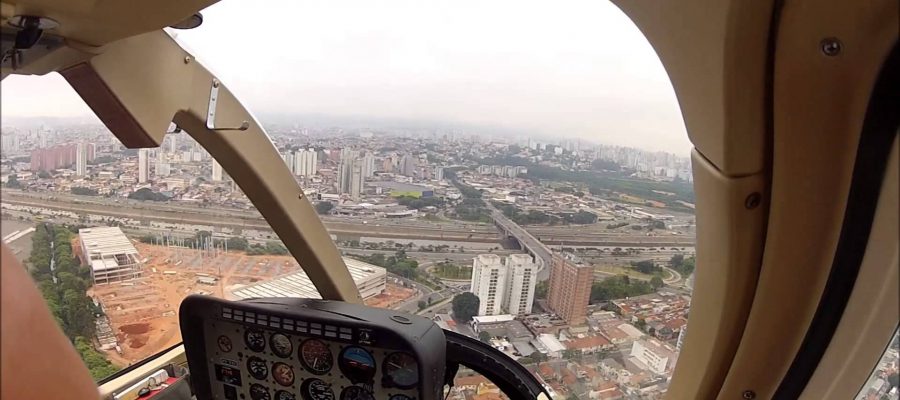It’s Three Different Airports!
When you refer to São Paulo Airport you have to be very specific. The first airport opened in São Paulo in 1919 and was named Campo de Marte Airport (SBMT), for the Parisian Champ de Mars, the public green space that took its name from the Roman Campus Martius. It’s still in operation, with 1,600 metre (5,250 ft.) runway, housing the São Paulo Flying School, and the 4th Command of the Brazilian Air Force. Most of the landings there are by helicopter, so let’s take a look at that.
The second possibility when someone speaks of the São Paulo Airport is the São Paulo–Congonhas Airport (CGH), which is tightly surrounded by the city itself. Travelers and business people love this airport for strictly local flights, since it lost its official international status in 2008, but they really stopped international flights in 1985.
As you can see from the image it’s impossible to extend the runways and they are far too short to accommodate a long haul jet. Just about the biggest thing we can land there is an A320 Airbus. Since every flight has to pass over the city, operations are only permitted between 6:00 AM and 10:30 PM. Here’s an example of landing in just a small Cessna Citation jet on these short runways.
Inside, it is a very attractive airport. It has undergone renovations with completely modern architecture, but in a neo-classical style. Plans for the airport itself arose in 1919 but it wasn’t until 17 years later when it finally opened. By 1957 it had grown to the third busiest cargo airport in the world.
Innovations included the world’s first shuttle service (1959) which made this airport internationally famous. They provided flights every half hour between São Paulo and Rio de Janeiro. And the ticketing process was simple because of the constant stream of people using the service.
In 1936 it was well away from the urban area of São Paulo, but the city grew, surrounding it, and permanently limiting its ability to expand. It started with a 300 m (< 1,000 feet) dirt runway, but now has one runway (17R/35L) which is 1940 m (6,365 ft.) long, and a companion runway (17L/35R) which is 1,435 m (4708 ft.), both composed of asphalt.
As mentioned above, these were too short for long haul jet international operations. The new airport, designed to handle international traffic opened in 1985, whereupon congested Congonhas Airport hosted only short-haul and regional flights.
That didn’t help the congestion, however, since noise abatement and safety restrictions limit them to 30 operations per hour. The largest percentage of business conducted in the country is in the southern region where São Paulo is, so this airport is destined to stay busy.
The Third Airport
São Paulo/Guarulhos–Governador André Franco Montoro International Airport (GRU) sports runways that are nearly as long as its official name, at 3000 m (9,843 feet) and 3,700 m (12,140 feet), which makes landing there a breeze as seen in this video. The local name for the airport is Cumbica Airport, after the district in which it is located.
To add that extra layer of reality, don’t forget to check out the Flight Radar. If you’re a fan of Air Traffic Control you can watch the skies around São Paulo-Guarulhos Airport here. Clicking on any plane will identify it for you, with pale blue being incoming flights, pale green being departing flights, and gray aircraft that are just passing through the airspace. As you can see, this airport is properly designed with runoff areas for planes that somehow manage to exceed its more than 2¼ miles of length.
Incidents
At all three airports, as usual, there are more incidents in the early years than there were in the later years once instrument flying techniques were invented and employed. But even in 2013 tiny Campo de Marte Airport had a Learjet leave the runway due to pilot inexperience with the jet, landing far too fast and touching down more than 1,000 from the beginning of the runway. Don’t fly with that guy!
SBMT
- Crash in 1947 crew survived; two civilians on ground killed;
- No injury crash in 1962;
- Jet lost power and aborted a takeoff in 1980 and left runway;
- Learjet overran the runway in 2013 while landing.
CGH
- 1940s Four deadly crashes;
- 1950s Five deadly crashes;
- 1960s Two crashes;
- 1970s One hijacking (hijacker shot, no other injuries); one crash;
- 1990s one crash, and one successful landing after bomb exploded, but one passenger was blown out of the craft due to uncontrolled decompression;
- Only one incident since, in the 2007; an aircraft overran the short runways, striking a warehouse killing all onboard and 12 on the ground.
GRU
- 1986 Foggy conditions, crew unknowingly tried to take off from a taxi way; aborted takeoff, running into dyke. 1 passenger killed;
- 1989 Crew error on cargo plane, activated speed brakes by mistake causing plane to lose lift and crash 2 km from airport killing 3 crew and 22 people on the ground;
- 1996 Learjet aborted first landing attempt. Tower instructed them to turn right, they turned left, and crashed into the mountains, killing all 9 aboard.
The Takeaway
When you look at the incident report above it’s easy to wring your hands and say “How awful”, but in truth, it’s actually a decent record. Modern instrumentation has made both CGH and GRU quite safe for the ordinary traveler.
São Paulo is a fascinating city, very modern in many respects, including a massive and extensive subway system, good surface transit including buses and trains, and even air taxi service. If you still retain notions of ancient South American natives, maybe it’s time for a visit to see what this city is really like!
